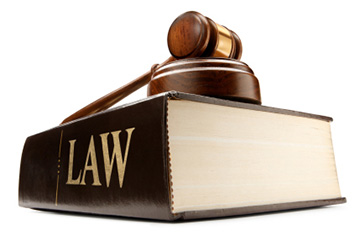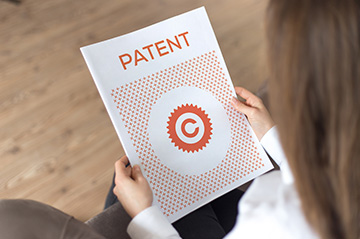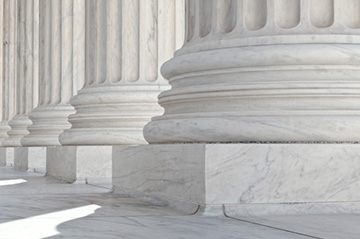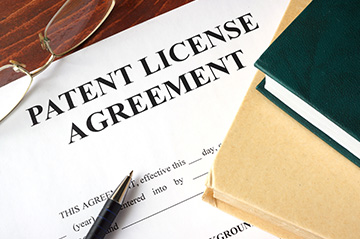A United States Patent is a federal government grant that allows its owner to exclude others from making, using, offering for sale, selling or importing into the country an invention which is claimed within the Patent. In the United States, the patent application process is administered by the United States Patent and Trademark Office (USPTO), which negotiates the “allowability” and claim scope of the Patent. Sherman IP attorneys are admitted before the USPTO, to practice in patent related matters and have advanced technical and engineering backgrounds for this purpose. Sherman IP is one of the few law firms that truly specialize in utility and design Patents for high technology products and systems.
These high technology industries include computers, telecommunications, optics, wireless communications technology, mobile devices, cloud technology/computing, semiconductors, materials processing technology, robotics, artificial intelligence, innovative consumer electronics, and neuromorphic computing, among others. Our Intellectual Property attorneys offer extensive legal experience plus the most advanced and wide ranging scientific and technical backgrounds based on education and work experience. We have helped to procure patents for a range of clients including electronic component manufacturers, telecommunication networks, and software engineering firms.
Click Here to view registered patents obtained by Sherman IP
A provisional patent application should be considered a temporary placeholder for an actual, non-provisional utility patent application that you are considering filing later.
 In and of itself, a provisional patent application does not undergo an extensive examination process. A provisional patent application cannot result in the granting of a valuable United States Patent or provide you with any Patent rights. Once it is filed, you have one (1) year to file an actual, non-provisional utility patent application relating to the same subject matter before your provisional patent application lapses.
In and of itself, a provisional patent application does not undergo an extensive examination process. A provisional patent application cannot result in the granting of a valuable United States Patent or provide you with any Patent rights. Once it is filed, you have one (1) year to file an actual, non-provisional utility patent application relating to the same subject matter before your provisional patent application lapses.
Although provisional patent applications don’t directly result in an issued US Patent, a provisional patent application does provide certain benefits that make them a valuable tool in pursuing patent protection.
A provisional patent application provides the means to establish an early effective filing date, while allowing you to enter the market and otherwise publicize your product or invention without losing valuable US and International patent rights. The law promotes an “Absolute Novelty” doctrine which dedicates known subject matter to the public. While the United States recognizes a grace period allowing you one year to file your patent application after publication, most countries do not. Once your invention is part of a product or service which is sold, or is otherwise made public, your future patent rights begin to disappear. The provisional patent application provides a cost effective way to preserve those rights.
The provisional patent application can also delay the costly preparation and filing of a related utility patent application until you can determine your market penetration, budget and need for patent protection. The provisional patent application is not substantively reviewed by the United States Patent Office, and does not require claims to be included, so it is usually much less costly than a related utility patent application.
Finally, the United States enacted a First to File patent system on March 16, 2013 with the America Invents Act. In a First to File system, the first person to file a patent application is entitled to the Patent Grant. The United States will no longer investigate whether you conceived of your invention before someone else did. If you want a Patent, you will be well served to file a patent application quickly, and a provisional patent application provides you an easy and cost effective vehicle for doing so.
SHERMAN IP generally provides two (2) types of services in helping you to file a provisional patent application. The first is an “AS IS” provisional patent application, and is less expensive because we are not dedicating attorney time in reviewing the quality of the information you are providing. Here, SHERMAN IP attorneys are not substantively reviewing your materials before filing, but are merely compiling, packaging and filing the information you are providing. This is as opposed to a “Section 112 Reviewed” provisional patent application where a SHERMAN IP attorney substantively reviews the materials you provide to make sure that you have provided sufficient information for us to later feel comfortable drafting the utility patent application based on a particular invention we are seeking to claim.
Information cannot be added to the provisional patent application once it is filed. When preparing your provisional patent application, include a description and supporting materials for everything that you think you might want to make part of your patent application. Don’t leave anything out! If you leave information out, then you cannot later claim priority to the provisional patent application for that information if you need to use the earlier effective filing date of the provisional patent application to preserve your rights.
 A utility patent protects the way something is used or works. A utility patent is the type of patent application that most people think about when they say that they “have a patent on that.” A utility patent can cover a product or a method for doing something.
A utility patent protects the way something is used or works. A utility patent is the type of patent application that most people think about when they say that they “have a patent on that.” A utility patent can cover a product or a method for doing something.
The end result of filing a utility patent application is the issuance of a Patent Grant for a product or invention that is deemed to have a new and useful purpose. This can be a process, machine, manufacture, composition of matter or a new and useful improvement to an existing article. Utility Patents allow Patentees to exclude others from the production, usage, offering for sale, selling the invention or importing into the United States any product which is the subject of the Patent or results from the patented technique.
A Utility Patent Grant can last for a period of up to twenty (20) years from the date of the patent application filing. However, maintenance fees must be periodically paid during the term of the Patent in order to prevent the Patent rights from lapsing and being dedicated to the public.
 A Design Patent is issued for a new, original and ornamental design as it applies to a manufactured item or material. Design Patents permit the Design Patentee to exclude the production, usage and sale of the design for a period of fourteen (14) years from the date the Patent grant is issued by the United States Patent Office. Unlike utility Patents, design Patents are not subject to maintenance fees.
A Design Patent is issued for a new, original and ornamental design as it applies to a manufactured item or material. Design Patents permit the Design Patentee to exclude the production, usage and sale of the design for a period of fourteen (14) years from the date the Patent grant is issued by the United States Patent Office. Unlike utility Patents, design Patents are not subject to maintenance fees.
 SHERMAN IP’s philosophy is that the hallmark of a true “expert” is someone who can easily explain to the uninitiated what is going on and what to expect in a process. The patent application process is complex and can be made much easier, less confusing, and more economical if everyone has an overview of what to expect.
SHERMAN IP’s philosophy is that the hallmark of a true “expert” is someone who can easily explain to the uninitiated what is going on and what to expect in a process. The patent application process is complex and can be made much easier, less confusing, and more economical if everyone has an overview of what to expect.
The SHERMAN IP Invention Review and the Invention Disclosure Form:
When new or existing clients come to us with inventions, products or ideas that they’d like to patent, we start with a client consultation or interview to discuss the development.
For this consultation, clients are asked to prepare a SHERMAN IP Invention Disclosure Form that provides a description of the invention and variously may include drawings, back-up documentation, the client’s research, or any other materials that help to understand the development and how it is differentiated from what came before.
View and download the SHERMAN IP Invention Disclosure Form here
You should know that the law provides a continuing obligation on you to disclose to the patent Examiner any known Prior Art or information that you know about which affects the validity and scope of the claims in your patent. SHERMAN IP attorneys and staff are experienced at helping you to provide this information to the United States Patent Office and in taking this information into account in processing your patent application. You should attach any known Prior Art (e.g., existing concepts, publications, patents, products, etc.) or the results of any searches and discuss any relevant information in the SHERMAN IP Invention Disclosure Form and immediately advise us if any new information comes up.
A SHERMAN IP attorney reviews the information in the SHERMAN IP Invention Disclosure Form, will ask questions about the disclosure and documents provided in the SHERMAN IP Invention Disclosure Form and invite the inventor to provide additional information where appropriate.
One of the points of inquiry here will be about any disclosures or sales involving the development. These publication events may serve to limit or even prevent a patent from being obtained. If they are planned for the future, these publication events will dictate the timing for the patent application filing in order to preserve your rights to patent your development.
A Patent Search:
Although not a requirement of the patent application process, SHERMAN IP strongly recommends that a novelty or patentability search be conducted to determine the general scope of the prior art which exists prior to proceeding with drafting and filing a patent application. A patentability search is a general overview of the available prior art conducted in an economic fashion to get a sense of whether your idea is novel. It will not uncover every piece of prior art available nor is it a guarantee of patentability. It is just a survey; but it is worthwhile to get an understanding of what you can expect the scope of your patent claims will look like.
 Most inventors will have conducted an internet and/or other search to determine their own expectation that their idea will be patentable and SHERMAN IP highly encourages you to do so for your invention as well. Regardless of the results of your search, SHERMAN IP has additional resources at its disposal that you may not. SHERMAN IP resources include the patent office records that the patent Examiners will be searching when they review your patent application, as well as many patent Examiners themselves. SHERMAN IP applies specialized search strategies to uncover the most relevant prior art.
Most inventors will have conducted an internet and/or other search to determine their own expectation that their idea will be patentable and SHERMAN IP highly encourages you to do so for your invention as well. Regardless of the results of your search, SHERMAN IP has additional resources at its disposal that you may not. SHERMAN IP resources include the patent office records that the patent Examiners will be searching when they review your patent application, as well as many patent Examiners themselves. SHERMAN IP applies specialized search strategies to uncover the most relevant prior art.
Again, while the patentability search is an additional cost at the beginning of the process, it can help create a general understanding of the scope of protection that may be available and help the client make a determination if it is worthwhile to proceed. While the patentability search is not fool proof, it is a recommended and worthwhile exercise. From the SHERMAN IP Invention Disclosure Form, and our general understanding of your invention, we can develop a budget for a patentability search to economically meet your needs.
 Once the SHERMAN IP Invention Disclosure Form and attachments are provided, the initial interview has been conducted, any additional subject matter has been provided (if requested), and the patentability search has been reviewed (if ordered), a SHERMAN IP attorney thoroughly reviews all of the information in the Invention Disclosure Form and other materials; taking the necessary hours or days to gain a deep understanding of the invention. Based on this review, SHERMAN IP begins its internal process including completing pre-application documents.
Once the SHERMAN IP Invention Disclosure Form and attachments are provided, the initial interview has been conducted, any additional subject matter has been provided (if requested), and the patentability search has been reviewed (if ordered), a SHERMAN IP attorney thoroughly reviews all of the information in the Invention Disclosure Form and other materials; taking the necessary hours or days to gain a deep understanding of the invention. Based on this review, SHERMAN IP begins its internal process including completing pre-application documents.
At this stage, a first draft of the patent application is drafted by the SHERMAN IP Attorney. This includes modifying or creating figures, putting together a thorough description of the invention and any preferred embodiments and developing the claims defining the invention.
Prior to drafting the claims, a claim scope strategy is developed by the SHERMAN IP attorney based upon the invention as conveyed by, you, the inventor, taking into account the known Prior Art and an economic interest in providing a level of protection that is going to be valuable to you. This is very important in protecting your invention. When someone says that they “designed around the patent” they’re saying that the claims were too narrowly drafted and there was a way to achieve the intended result without being covered by the claims. The claims define the “meets and bounds” of the invention. The claims are the most important part of the application and determine the scope of protection for your invention.
A basic patent application should include the following sections, in order:
- Title of the Invention,
- Cross-reference to related applications,
- Statement regarding prior disclosures by the inventor or a joint inventor,
- Background of the invention,
- Brief summary of the invention,
- Brief description of the several views of the drawing,
- Detailed description of the invention,
- A claim or claims, and
- Abstract of the disclosure.
Once the first draft of the patent application is completed, it is provided to you by the SHERMAN IP Attorney. SHERMAN IP’s practice is to also include any questions or requests for further information in the first draft patent application. Once you return the first draft patent application with your comments and any questions, the SHERMAN IP Attorney may then contact you to review your comments, and hopefully the document can be placed in final form for your final review.
 The United States Patent Laws require that each inventor states under oath, subject to the penalty of perjury, that they are the inventor, or one of the stated original inventors, of the claimed invention in the patent application and that they authorize the patent application to be filed. Once the patent application is ready to be filed, SHERMAN IP will provide you with a Declaration to execute serving this purpose, and stating that you have reviewed the final patent application and declaring these statements.
The United States Patent Laws require that each inventor states under oath, subject to the penalty of perjury, that they are the inventor, or one of the stated original inventors, of the claimed invention in the patent application and that they authorize the patent application to be filed. Once the patent application is ready to be filed, SHERMAN IP will provide you with a Declaration to execute serving this purpose, and stating that you have reviewed the final patent application and declaring these statements.
The Declaration will also remind you of your Duty of Candor. This is a Duty that you have to provide any and all material information that you know about to the United States Patent Office that might affect the validity or scope of your claims. You don’t have a duty to find information, but if you know about information, your Duty of Candor requires you to tell the United States Patent Office.
The US Patent Laws also recognize that ownership of the claimed invention is initially with the person who created it. Therefore, SHERMAN IP may also provide you an Assignment where you transfer those rights to another person or entity. This is necessary if you have signed an Employment or other agreement agreeing to transfer your rights.
After all the parties have reviewed and approved the patent application, SHERMAN IP prepares all related documents and transmittal materials and files it with the United States Patent Office. SHERMAN IP sends any related Assignments for recording with the United States Patent Office as well. The United States Patent Office maintains the sole repository to record transfers of ownership of US patent rights.
 Once your patent application is properly filed with the United States Patent Office, the Patent Office will issue an Official Filing Receipt with the United States Application Serial Number and the Filing Date. This official Filing Date is important because when it relates to Patents, dates are very meaningful in classifying Prior Art. The Patent Office will then classify the application based upon the technology involved and allocate it to a Patent Examiner for search and review.
Once your patent application is properly filed with the United States Patent Office, the Patent Office will issue an Official Filing Receipt with the United States Application Serial Number and the Filing Date. This official Filing Date is important because when it relates to Patents, dates are very meaningful in classifying Prior Art. The Patent Office will then classify the application based upon the technology involved and allocate it to a Patent Examiner for search and review.
After the Examiner receives the patent application, they read the specification and claims. Based upon their review of the patent application, the Examiner then compiles a search strategy and searches the prior art to determine if the claims define a new and useful invention.
The Examiner will then usually issue an Official Action that may include objections and rejections to the specification, drawings and claims. These objections and rejections will normally consist of positions taken under 35 USC Section 101 (Statutory Subject Matter), Section 102 (lack of novelty and direct anticipation of the claims by the Prior Art), Section 103 (lack of novelty because the claims are considered obvious from the Prior Art), or Section 112 (problems with how the specification describes the invention).
One type of Official Action is known as a Restriction Requirement. In a Restriction Requirement, the Examiner determines that there are two or more inventions claimed within your patent application. The United States Patent Office only allows one (1) invention to be claimed within a patent application. If the Examiner has determined that there are multiple distinct inventions claimed within one patent application, the Examiner will require you to choose one of the noted inventions and restrict the others out. You will be allowed to pursue the restricted claims in Divisional patent applications, where you must pay additional fees to have those restricted inventions examined.
You should not be disappointed that you received an Official Action from the United States Patent Office. An Official Action citing Prior Art means that you are negotiating with the Patent Examiner about claim scope and validity. A “first action Allowance” means that you either claimed your invention so that the Patent Examiner could not find any relevant Prior Art that could conflict with your claimed invention, or you may have claimed your invention too narrowly.
You should consider the patent application process as a negotiation that you are undertaking with the United States Government about the scope of your Patent Rights. It involves a back and forth discussion regarding your claim scope and involves real economic value, just like any other negotiation you undertake in your life.
At each stage you should be deciding whether continuing the negotiation is economically worthwhile in obtaining the scope of rights you are seeking or whether you should capitulate to the scope of rights being offered by the Patent Examiner on behalf of the United States Government. The failure to get any Official Action means that you were never really negotiating. You simply sold too low!! SHERMAN IP Attorneys are trained to help you understand what you are fighting for, the likelihood of getting wider claim scope and the cost you will undertake in proceeding.
 Once you receive the Official Action, you have six (6) months to prepare and file a response to most Official Actions. However, generally any responses filed more than three (3) months after the Official Action require you to pay increasing monthly extension fees and should be avoided.
Once you receive the Official Action, you have six (6) months to prepare and file a response to most Official Actions. However, generally any responses filed more than three (3) months after the Official Action require you to pay increasing monthly extension fees and should be avoided.
Your response will take the form of an Amendment or Response addressing the Examiner’s objections and rejections, including amending the claims to avoid the Examiner’s cited Prior Art and making arguments about why the Examiner’s positions are misplaced. In many ways, the preparation of the appropriate response strategy is an art form in convincing the Examiner to allow the application, and SHERMAN IP attorneys are well versed in techniques to obtain the largest claim scope in the quickest manner at the most efficient cost. However, often the success of the response depends on the subjective opinion of the Patent Examiner that is assigned your patent application. An Examiner Interview may also be held in the process, and your SHERMAN IP attorney may recommend holding an Examiner Interview to advance your case.
At some point in the process, the Examiner may issue a Final Rejection. In a Final Rejection, the Examiner believes that a clear issue has developed between the Examiner and the Applicant. You simply disagree as to whether the claims in their stated form present allowable subject matter. Again, SHERMAN IP attorneys are trained to help you understand the issue so that you can make a business decision whether to Appeal the Examiner’s decision, to capitulate to the Examiner’s position or to pursue some other avenue to continue pursuing your desired claim scope.
 If you are unable to reach agreement with the Patent Examiner during the patent application process, and after the Examiner twice rejects your claims, it is possible to seek review of the Examiner’s opinion by filing a Notice of Appeal and an Appeal Brief with the Patent Trial and Appeal Board (PTAB). This is a specialized proceeding where an Appeal Brief is filed and the matter is reviewed by a panel of three members who review the Examiner’s position and make a determination.
If you are unable to reach agreement with the Patent Examiner during the patent application process, and after the Examiner twice rejects your claims, it is possible to seek review of the Examiner’s opinion by filing a Notice of Appeal and an Appeal Brief with the Patent Trial and Appeal Board (PTAB). This is a specialized proceeding where an Appeal Brief is filed and the matter is reviewed by a panel of three members who review the Examiner’s position and make a determination.
SHERMAN IP attorneys have extensive experience in taking matters to Appeal and prevailing to obtain successful determinations for our clients.
 A United States Patent only grants rights in the United States and its territories. Outside the United States, patent rights are controlled by the applicable country or region being affected. The United States has executed treaties which allow United States citizens and entities to pursue patent protection in other countries and there are specialized avenues to pursue those patent rights.
A United States Patent only grants rights in the United States and its territories. Outside the United States, patent rights are controlled by the applicable country or region being affected. The United States has executed treaties which allow United States citizens and entities to pursue patent protection in other countries and there are specialized avenues to pursue those patent rights.
Foreign patent protection is more important now than ever before due to the global economy and the ability to sell into and out of the United States using the World Wide Web.
SHERMAN IP attorneys are well versed in pursuing patent protection outside of the United States, whether that be navigating the Patent Cooperation Treaty (PCT) procedures, obtaining foreign filing licenses for the export of technology or simply filing your patent application in other countries or regional repositories using your priority claims in your US patent applications. SHERMAN IP maintains ongoing and strong relationships with attorneys in countries throughout the world to advise you properly about your foreign patent rights.
 SHERMAN IP has proprietary systems for managing portfolios of intellectual property including multiple related foreign and domestic patent applications and issued Patents. These types of proprietary management systems are necessary for clients that have many inter-related patent applications being filed and pursued in order to protect a continuing research and development effort in a business. Often larger companies will have multiple portfolios to protect different research and development effort, which may or may not inter-relate to each other. Likewise, these multiple patent properties must be accounted for in their related technology families. Owners of these inter-related portfolios have special Duties of Candor that need to be accounted for.
SHERMAN IP has proprietary systems for managing portfolios of intellectual property including multiple related foreign and domestic patent applications and issued Patents. These types of proprietary management systems are necessary for clients that have many inter-related patent applications being filed and pursued in order to protect a continuing research and development effort in a business. Often larger companies will have multiple portfolios to protect different research and development effort, which may or may not inter-relate to each other. Likewise, these multiple patent properties must be accounted for in their related technology families. Owners of these inter-related portfolios have special Duties of Candor that need to be accounted for.
Special requirements have to be addressed to deal with inter-related patent properties, whether those inter-relationships are for multiple patent applications on different aspects of a single technology, or even across international borders. Something that happens in a related European case often needs to be accounted for in the United States.
SHERMAN IP’s proprietary systems are necessary due to the complexity of managing ever expanding patent portfolios across multiple patent applications that are combined into one asset for ease of management. SHERMAN IP’s proprietary systems allow our team of attorneys and legal staff to manage high profile portfolios and undertake the special responsibilities of managing multiple patent properties on our client’s behalf.
 The experience and ingenuity of SHERMAN IP attorneys adds value to our client’s patent applications. Many inventors sometimes arrive at their concept(s) in a “tunnel” as they are trying to solve one particular problem. SHERMAN IP attorneys have the ability, creativity and vision to help the inventor derive additional concept applications, alternative embodiments, and future development potential for their inventions.
The experience and ingenuity of SHERMAN IP attorneys adds value to our client’s patent applications. Many inventors sometimes arrive at their concept(s) in a “tunnel” as they are trying to solve one particular problem. SHERMAN IP attorneys have the ability, creativity and vision to help the inventor derive additional concept applications, alternative embodiments, and future development potential for their inventions.
Some important strategies in patent application drafting which provide patent application robustness involve: foreseeing potential infringers, determining potential “design around(s),” coming up with alternative embodiments, determining detectability of infringing use, application of the inventive concept(s) to other technologies, concept expansion and taking account of recent changes in the law and USPTO rules. SHERMAN IP attorneys are well versed in these strategies and incorporate these strategies when drafting the patent application description and claims.
By assisting in developing concept expansion, SHERMAN IP attorneys assist inventors to envision further potential markets for their inventions. Combined with our legal expertise, educational knowledge and work experience, we wear our “inventor’s hat” in order to help the inventor expand inventive concepts and even derive new concepts, which results in further added value to all of your Intellectual Property needs.

